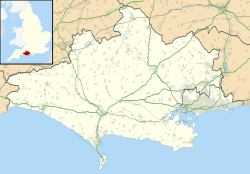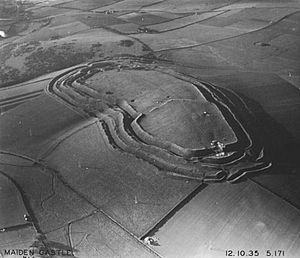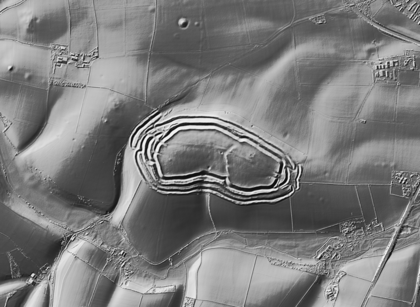Maiden Castle, Dorset facts for kids
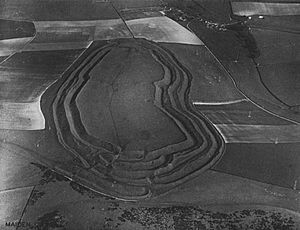
Maiden Castle in 1934
|
|
| Location | Winterborne St Martin, Dorset |
|---|---|
| Coordinates | 50°41′40″N 2°28′05″W / 50.694495°N 2.468192°W |
| Type | Hillfort |
| Area | 6.4 ha (16 acres) (first hill fort) 19 ha (47 acres) (developed hill fort) |
| History | |
| Founded | 600 BC (first hill fort) 450 BC (developed hill fort) |
| Periods | Iron Age |
| Cultures | Durotriges |
| Site notes | |
| Ownership | English Heritage |
| Public access | Yes |
Maiden Castle is a very old hill fort from the Iron Age. It is located about 1.6 miles (2.6 km) southwest of Dorchester in Dorset, England. Hill forts were like ancient towns built on top of hills. They had strong walls and ditches for protection. People lived in them during the Iron Age, which was a long time ago.
The first signs of people living here are from the Neolithic period, around 4000 BC. Later, in the Bronze Age (about 1800 BC), people used the land for farming. Then, the site was left empty for a while. The main hill fort, Maiden Castle, was built around 600 BC. At first, it was a simple fort, covering about 6.4 hectares (16 acres). But around 450 BC, it became much bigger, almost tripling in size to 19 hectares (47 acres). This made it one of the largest hill forts in Britain and even in Europe!
The fort's defenses also became more complex with many ramparts (earth walls) and ditches. Around 100 BC, fewer people lived there, and they mostly stayed at the eastern end. Maiden Castle was used until at least the Roman period. At that time, it was part of the land of the Durotriges, a Celtic tribe.
After the Roman conquest of Britain in the 1st century AD, Maiden Castle seems to have been left empty. However, the Romans might have had soldiers there for a short time. Later, in the late 4th century AD, a temple and other buildings were built on the site. By the 6th century AD, the hilltop was completely abandoned. For hundreds of years after that, it was only used for farming.
Maiden Castle has inspired many artists, like composer John Ireland and writers Thomas Hardy and John Cowper Powys. Archaeologists like Augustus Pitt Rivers and Mortimer Wheeler have studied hill forts and Maiden Castle. Today, English Heritage looks after the site, and it is open for everyone to visit.
Contents
Life Before the Hill Fort
Before the big hill fort was built, people lived on this hill. Around 4000 BC, during the Neolithic period, they built something called a causewayed enclosure. It was an oval area with two ditches. These ditches had gaps, like causeways, and the banks were not very high. This means it probably wasn't built for defense.
Instead, the ditches might have been symbolic, separating the inside from the outside. Archaeologists think the hill's great views were important. The ditches, when first dug, would have shown bright white chalk against the green hill, making them easy to see from far away.
Inside the enclosure, archaeologists found the graves of two children, aged 6–7. This suggests the site was important for rituals, maybe connected to death. Pottery from different areas was also found, showing that people traveled long distances to meet here. The enclosure was abandoned around 3400 BC. Some arrowheads found might mean there was some conflict at the end of its use.
About 50 years later, a long mound called a bank barrow was built over the enclosure. It was 546-metre (1,791 ft) long with ditches on each side. Unlike most barrows, it didn't cover any graves. Experts think it was a boundary marker, showing a special line in the landscape. For 500 years after this, not many people lived on the hill.
Around 1800 BC, in the early Bronze Age, the hill was cleared for farming. But the soil quickly became poor, and the site was abandoned again. It stayed empty until the Iron Age, when the famous hill fort was constructed. The old bank barrow remained as a low mound, and people avoided building over it.
Building the First Hill Fort
Hill forts started to appear in Britain around 1000 BC. Why they were built is a big question for archaeologists. Some think they were for defense against invaders. Others believe they were built because more people meant more competition for land and resources.
Many experts now think that changes in society led to hill forts. When iron became more common, it changed how people traded. This might have shifted power to new groups of people.
Archaeologist Barry Cunliffe suggests that hill forts offered protection when arguments between communities turned into fights. He says they weren't always built because of war, but they were useful strongholds when tensions were high.
Dorset has about 31 hill forts. Maiden Castle was likely used to control farming land for a large community. The huge defenses, like the ditch at Maiden Castle, show that land was valuable and communities fought over it. The complex entrances, like those at Maiden Castle, were designed to slow down attackers. This gave defenders time to use slings to throw stones at them. Many sling stones have been found at these sites.
The first hill fort at Maiden Castle was built around 600 BC. It covered about 6.4 hectares (16 acres) and had one ditch around it. The hill is part of a ridge that rises about 40 m (131 ft) above the nearby countryside. The defenses were about 8.4 m (28 ft) high, with a V-shaped ditch and a rampart. The rampart likely had timber (wood) walls, especially near the entrances, to look impressive.
The fort had two entrances: one in the northwest and a unique double entrance in the east. The reason for a double entrance is not clear. Some think it might have been to separate different farming communities living inside the fort.
The defenses of this first fort were rebuilt at least once. The ditch was made deeper, up to 7 m (23 ft) deep. The earth dug out was piled onto the rampart. The eastern entrances also became more complex. A bank and ditch were added outside the two entrances, and a bank was built between them. This bank had a wall made of limestone, brought from over 3 km (2 mi) away. This would have made the entrance look very grand and showed the fort's high status.
Most of the early Iron Age remains have been destroyed by later building. But by looking at similar forts nearby, archaeologists think Maiden Castle was likely full of houses and storage areas. Not much is known about the daily life or economy of this early period, as few items have been found.
The Expanded Hill Fort
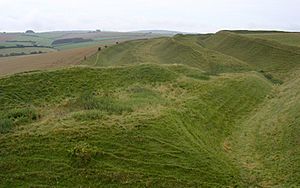
In the early Iron Age, Maiden Castle was just one of many hill forts. But in the Middle Iron Age, around 450 BC, it grew much larger. It became the biggest hill fort in Britain and one of the largest in Europe! It expanded from 6.4 to 19 ha (16 to 47 acres). At first, this new area had a single bank and ditch.
This expansion was part of a trend in southern England. As some hill forts grew, many smaller ones were no longer used. The larger, "developed hill forts" like Maiden Castle were spaced far apart. This suggests they became very important centers.
The growth of these large hill forts shows that Iron Age society was becoming more complex. One dominant hill fort in an area might mean that its people became more powerful, perhaps through warfare. However, there's not much evidence of widespread destruction. Instead, more crafts and industries appeared, suggesting economic reasons for the changes. Hill forts might have become important trading centers.
The many rings of ditches and ramparts (called "multivallate") at places like Maiden Castle were not just for defense. They were also a display of power and authority. These developed hill forts were usually densely populated. Maiden Castle's huge defenses likely mean it was more important than other developed hill forts.
Maiden Castle expanded westward, taking in the nearby Hog Hill. A dry valley separated the two hilltops, and a shaft dug into it might have been a water source. Soon after the expansion, work began to make the defenses even stronger. The existing rampart was made taller, and more ramparts and ditches were added. On the south side, there were four ramparts and three ditches! The eastern entrance was also made even more complex, making it harder for attackers to reach.
Archaeologists found four-post structures inside the fort. These were too small for houses, so they were probably granaries, used to store grain. This suggests the fort controlled the area's food supply. Not many houses from the 5th century BC have been found, possibly because later quarrying destroyed the evidence. It seems houses were built closer to the ramparts only after the defenses were finished. People lived in roundhouses throughout the Iron Age. Later houses seem to be arranged in rows and are similar in size, which might show that leaders had more control over society.
Bronze items like pins and jewelry were found from the Middle Iron Age. Since there was no local source for tin and copper (to make bronze), this shows long-distance trade. While bronze wasn't made at Maiden Castle, it was reshaped there. Good iron ore was available nearby, but Maiden Castle wasn't a major iron production center in this period.
Most pottery found at Maiden Castle in the early Iron Age came from nearby. But later, pottery from further away became more common. By the Late Iron Age, 95% of the pottery came from the Poole Harbour area, over 35 mi (56 km) away. This long-distance trade suggests stronger connections between different groups of people. While Maiden Castle wasn't a true city, some archaeologists describe these developed hill forts as "town-like settlements."
Decline and Roman Times
Around 100 BC, many hill forts across Britain were used less. This might have happened because of more contact with the Roman Empire. New industries and the use of coins might have changed society, making the old hill fort leaders less powerful. In Dorset, many hill forts were abandoned, and people moved to small, unprotected farmsteads.
Around 100 BC, the organized layout of Maiden Castle changed. The western part was abandoned, and people focused on living in the eastern half. Some of the earthworks around the eastern gateway were filled in, and settlement spread beyond the entrance. Archaeologist Mortimer Wheeler found houses, storage pits, an iron-working area, and a cemetery here.
In the iron-working area, over 62 kg (137 lb) of iron waste was found. It's thought that about 200 kg (440 lb) of iron was produced here. The ore needed for this amount of iron likely came from specialist iron production areas far away. Maiden Castle was one of the most important iron production sites in southern Britain during the Late Iron Age.
Not much evidence of burials from the early Iron Age exists. It's thought that bodies were often left exposed to the elements. Wheeler's excavations in the cemetery near the eastern gateway found 52 burials. Some of these bodies showed signs of a violent death, including one with a Roman catapult bolt in its back. Wheeler believed this was evidence of a Roman attack on Maiden Castle.
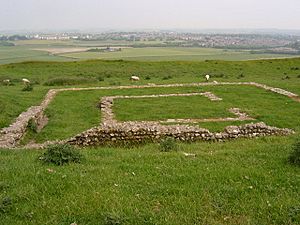
The Roman conquest of Britain began in AD 43. Roman forces, led by Vespasian, campaigned in southwest Britain from AD 43–47. While Wheeler's story of a fierce Roman attack on Maiden Castle is famous, there isn't much archaeological proof for it. There is a layer of charcoal, but it's linked to the iron works, not a widespread fire. And while some bodies in the cemetery showed signs of violence, there's no clear evidence they died during a Roman attack on the fort itself.
The eastern part of the hill fort was still used for a few decades after the Romans arrived. Many Roman items from the 1st century have been found near the east entrance. Some think Maiden Castle might have been used as a Roman military outpost or fort. This was common for hill forts in the southwest during Vespasian's campaign.
Maiden Castle was abandoned by the end of the 1st century AD. At this time, Durnovaria (modern Dorchester) became important as the main town for the Durotriges tribe. Later, sometime after 367 AD, a Roman-Celtic temple was built in the eastern part of Maiden Castle. Coins found under a mosaic floor helped date it. The temple had a central room surrounded by a passageway, like many Roman-Celtic temples in southern England. Two other buildings nearby might have been a priest's house and a shrine. The fort's eastern gateway was also improved around this time, possibly with another shrine inside.
Later History and Discoveries
The 4th-century temple slowly fell out of use, and Maiden Castle became mostly pasture land. There are a few burials from after the Roman period, some possibly Christian. But the hill fort was not used as a settlement again. In the 16th and 17th centuries, a barn was built over the area Wheeler called the "war cemetery." The only other major activity was a short period of farming in the 17th century, leaving behind traces of old plough lines.
The name "Maiden Castle" was first written down in 1607. This name is found in several other places in Britain. It often means a "fortification that looks impossible to capture" or one that has never been taken in battle. Another idea is that the name comes from an old British word, mai-dun, meaning "great hill."
Over the centuries, the site was completely abandoned and became open fields. However, it interested people who studied old things. The writer Thomas Hardy, whose house was near the castle, wrote about it in a short story. In 1921, composer John Ireland wrote a musical piece called Mai-Dun about the hill fort. And John Cowper Powys wrote a novel called Maiden Castle in 1936.
Archaeological Investigations
The first big studies of hill forts happened in the late 1800s. But it wasn't until the 1930s that Maiden Castle was properly investigated. Between 1934 and 1937, Mortimer Wheeler and Tessa Verney Wheeler dug up parts of the fort's inside and its defenses. Their work was paid for by public donations. Wheeler used the media to share his findings, which made Maiden Castle very famous. It was one of about 80 hill forts excavated during a period known as "hill fort mania" in the 1920s and 1930s.
Later, from 1985 to 1986, more excavations took place under Niall Sharples. These were needed because the hill fort was getting damaged, partly by the many visitors. English Heritage helped with repair work and archaeological studies at the same time. Sharples used new techniques, like radiocarbon dating, which helped to find the exact age of things at the site.
Maiden Castle became a Scheduled Ancient Monument in 1981. This protects it from unauthorized changes. Today, English Heritage maintains the site. It has parking and information boards, and it's open to the public all year round.
Images for kids
See also
 In Spanish: Castillo Maiden para niños
In Spanish: Castillo Maiden para niños


